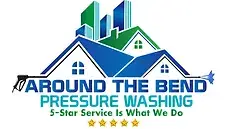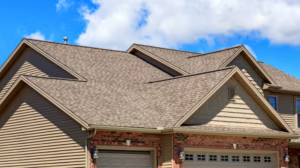Soft Washing Your Roof the Professional Way
Your roof is one of the most critical parts of your home, protecting you from the elements and contributing significantly to your property’s curb appeal. However, over time, it can accumulate dirt, moss, algae, and other debris that not only detract from its appearance but can also cause damage. Soft washing is the preferred method for cleaning roofs, especially delicate surfaces like shingles, because it is effective yet gentle.
To learn more about the basics of roof cleaning, read this blog Roof Cleaning 101: The Benefits of Soft Washing Your Roof.
In this guide, we’ll explore the professional approach to soft washing your roof to keep it looking its best without causing damage.
Why Soft Washing is the Best Method for Roof Cleaning
Soft washing differs from traditional pressure washing in that it uses low pressure combined with specialized cleaning solutions to remove dirt, algae, and moss from your roof. Here’s why soft washing is the superior choice:
- Protects Your Roof: High-pressure washing can strip away shingles, damage tiles, and even lead to leaks. Soft washing is gentle, ensuring your roof stays intact.
- Long-Lasting Results: The cleaning solutions used in soft washing not only clean but also kill algae, mold, and mildew at the source, preventing regrowth and keeping your roof cleaner for longer.
- Eco-Friendly: Professional soft washing uses biodegradable cleaning solutions that are safe for your roof, landscaping, and the environment.
If you’re curious about why soft wash methods are often recommended, read this blog Why Soft Wash House Cleaning is the Best Choice for Your Home.
To learn more about the differences between soft washing and pressure washing, check out The Advantages of Soft Washing Over Pressure Washing.
How Soft Washing Works
Soft washing involves a few critical steps that ensure your roof is thoroughly cleaned without any damage:
- Inspection and Preparation
Before starting the soft wash, a thorough inspection of your roof is essential. This allows professionals to identify any areas that need special attention or repair before cleaning. Preparation includes covering plants, outdoor furniture, and other areas that could be affected by the cleaning solution. - Application of Cleaning Solution
A specialized, eco-friendly cleaning solution is applied to your roof using low-pressure equipment. This solution breaks down dirt, algae, and moss, making it easier to remove. Unlike high-pressure washing, which can force water under your shingles, soft washing applies the solution gently to avoid damage. - Dwell Time
After application, the cleaning solution needs time to work. This dwell time allows the solution to penetrate and kill the root systems of algae and moss. The result is a deeper clean and fewer chances of rapid regrowth. - Rinsing
Once the cleaning solution has done its job, the roof is rinsed with low-pressure water. This step removes the loosened debris and any remaining cleaning solution, leaving your roof clean and free of contaminants. - Final Inspection
After rinsing, a final inspection is conducted to ensure that all areas have been thoroughly cleaned and that no damage has occurred. Any necessary touch-ups are performed at this stage.
Benefits of Professional Soft Washing
Hiring professionals for soft washing your roof offers several advantages:
- Expertise: Professionals understand the delicate nature of roofs and know how to clean them without causing damage.
- Safety: Roof cleaning can be hazardous. Pros have the right equipment and training to do the job safely.
- Efficiency: With experience and specialized tools, professionals can complete the job quickly and effectively, often with longer-lasting results than DIY methods.
To learn more about whether soft washing can harm your roof, read this blog Is Soft Washing Damaging to Your Roof?.
When to Soft Wash Your Roof
It’s generally recommended to soft wash your roof every 1 to 3 years, depending on your location and the amount of debris your roof collects. Homes in humid climates or shaded by trees may need more frequent cleaning due to higher risks of algae and moss growth. If you notice dark streaks, moss, or a buildup of debris on your roof, it’s time to consider a soft wash.
For more guidance on timing your roof cleaning, check out this blog How Often Should You Soft Wash Your Roof?.
Common Mistakes to Avoid
While soft washing is a safer alternative to pressure washing, it’s essential to steer clear of these common mistakes:
- Using High Pressure: Never use high-pressure settings on a roof, as this can cause significant damage.
- Ignoring Safety Measures: Always prioritize safety by wearing appropriate gear and using secure ladders or scaffolding.
- Skipping Inspections: Failing to inspect the roof before and after cleaning can lead to overlooked damage or incomplete cleaning.
If you’re also considering pressure washing other areas of your home, learn the right steps in this blog How to Pressure Wash Your Home Like a Pro: Ultimate Guide for Homeowners.
Why Choose Around The Bend Pressure Washing for Soft Washing
At Around The Bend Pressure Washing, we specialize in soft washing techniques that protect and preserve your roof’s integrity. Our team uses industry-leading equipment and eco-friendly solutions to ensure your roof is cleaned thoroughly and safely. Whether your roof needs a routine cleaning or a more intensive treatment, we tailor our services to meet your specific needs.


3 thoughts on “Soft Washing Your Roof the Professional Way (3 Best Methods)”
Pingback: Roof Cleaning 101: The Benefits of Soft Washing Your Roof - Tallahassee Pressure Washing Services
Pingback: Debunking the Most Common Pressure Washing Myths - Tallahassee Pressure Washing Services
Pingback: Why Soft Wash House Cleaning is the Best Choice for Your Home - Tallahassee Pressure Washing Services